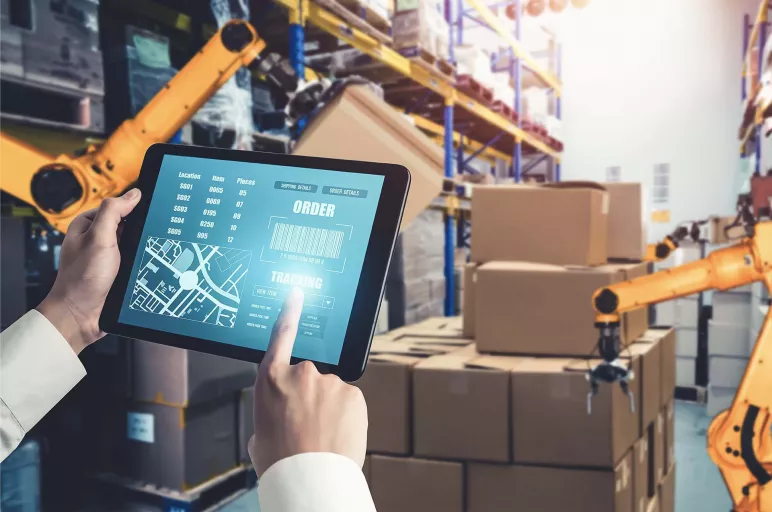
AI in Inventory Management: Decoding the Challenge
- Inventory management has so far been based on historical data, some set rules, and at times gut feeling.
- AI-driven inventory management ecosystems ensure that enterprise decisions are based on data, not hunches.
- Enterprises can cash in on AI's ability to ensure products are in stock when customers want them, thereby significantly enhancing customer satisfaction.
September 22, 2023 | Inventory Management Software 4 minutes read
Managing inventory has always been a complex task for enterprises, with the need to constantly juggle stock levels to ensure products are available right when customers want them — and at the same time, minimizing holding costs. Inventory management has so far been based on historical data, some set rules, and at times gut feeling. But this approach has reached its saturation, showcasing its many limitations!
Challenges in Inventory Management
Inventory can be a significant expense, so businesses need to minimize their investment in inventory without running out. Now, on the other hand, businesses do need to have enough inventory on hand to meet customer demand, but they don't want to overstock, as this can lead to lost profits.
Let's take a look at some of the inventory management challenges that businesses may face.
Inaccurate Forecasts
Relying solely on historical data often leads to inaccurate demand forecasts. Changes in consumer behavior, market trends, or external factors like weather can throw these forecasts off track.
Overstock and Understock
Inaccurate forecasts often result in overstocking or understocking. Overstock ties up capital in excess inventory and can lead to obsolescence, while understocking leads to lost sales and dissatisfied customers.
High Holding Costs
Excess inventory incurs costs for storage, insurance, and the risk of shrinkage or obsolescence. These costs eat into profits.
Missed Opportunities
On the flip side, understocking means missed sales opportunities. Customers who can't find what they want are likely to turn to competitors.
How AI Leads to Better Inventory Management
The AI advantage in inventory management is now clear. With machine learning algorithms that can analyze vast amounts of data, identify patterns, and make predictions with incredible accuracy, AI is driving transformational change.
Let's delve into how AI is transforming inventory management.
Accurate Demand Forecasting
AI algorithms can analyze historical sales data, market trends, and a bunch of external factors that affect demand — such as social media trends, economic indicators, and even news events. This results in far more accurate demand forecasts than traditional methods.
This is especially beneficial for online businesses that might want to predict demand for a new gadget. AI can factor in not only past sales data, but also real-time social media buzz, reviews, and news mentions related to that gadget.
Dynamic Replenishment
With AI's precise demand forecasts, inventory replenishment becomes dynamic. Instead of relying on fixed reorder points, AI-driven systems adjust order quantities based on real-time data. This ensures retailers neither overstock nor understock.
Seasonal and Trend Analysis
AI's pattern recognition capabilities excel when dealing with seasonal products or trends. It can identify not just annual patterns but also shorter-term trends. This is invaluable for businesses that deal with products sensitive to changing consumer preferences.
Supplier Performance Insights
AI extends its benefits to supplier relationships. It can evaluate supplier performance by analyzing metrics such as delivery times, quality, and pricing accuracy. In manufacturing for example, AI can monitor how different suppliers meet their delivery deadlines. If a supplier consistently delivers late, AI can recommend shifting orders to more reliable suppliers and avoid any production delay.
Reducing Holding Costs
AI helps reduce holding costs by ensuring that there’s only the inventory that’s needed. With accurate demand forecasts and dynamic replenishment, enterprises can avoid excess inventory sitting on shelves — saving on storage, insurance, and associated costs.
Furthermore, AI can predict when products are at risk of obsolescence. For example, in the tech industry, it can identify when products are becoming outdated and recommend discounting or liquidating them before they become a liability and increase holding costs.
Enhancing Customer Satisfaction
A happy customer is a returning customer, and therefore the lifeblood of any business. Enterprises can cash in on AI's ability to ensure products are in stock when customers want them, thereby significantly enhancing customer satisfaction.
Data-Driven Decision Making
AI-driven inventory management ecosystems ensure that enterprise decisions are based on data, not hunches. And this data-driven approach extends to everything — from optimizing product assortments to deciding on pricing strategies. For example, AI can analyze data to suggest specific products to promote during specific seasons or events. It can also accurately recommend products that an enterprise can bundle together for higher sales. It can even adjust prices dynamically based on real-time market dynamics.
Conclusion
Artificial intelligence thrives better in a dynamic and data-rich ecosystem. And this holds a lot of significance for inventory management. Enterprises can benefit from the enhancements that AI brings in — including accurate demand forecasting and dynamic replenishment — which can help reduce holding costs, enhance customer satisfaction, and ultimately boost business profitability.
Enterprises that are open to AI in inventory management system can gain a significant competitive edge — by making data-driven decisions, staying agile in changing market dynamics, and delivering exceptional customer experiences.
Also Read: Inventory & Warehouse Management Guide: What Why & How




